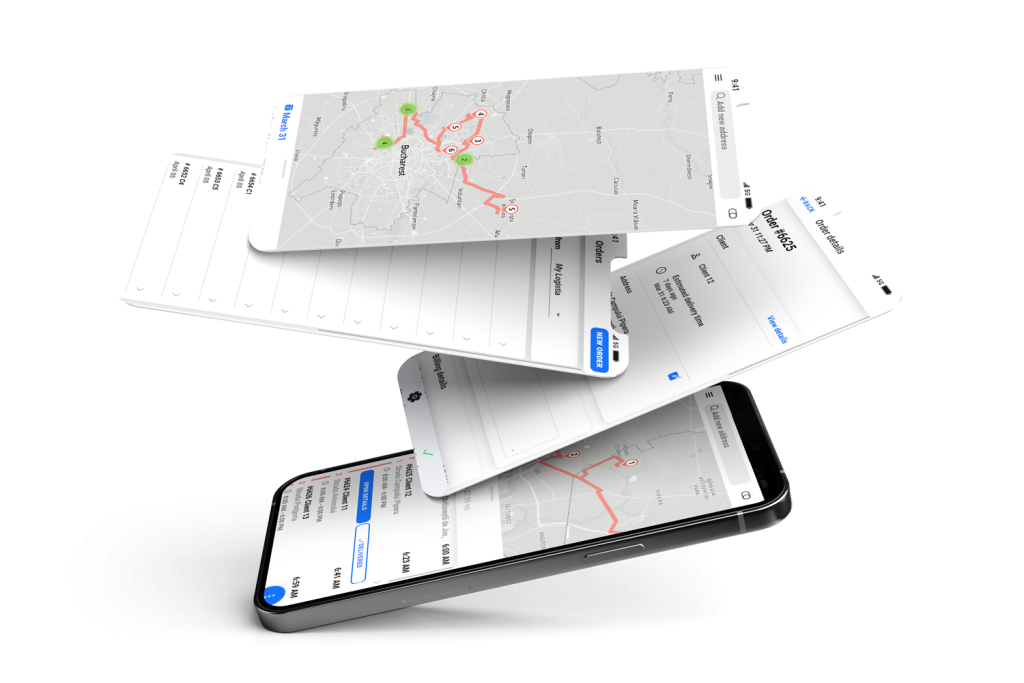Choosing the best apps for route planning
Today there’s a heightened expectation for punctual and efficient delivery services. Be it the latest gadget, an eagerly awaited book, or essential office equipment, on-time deliveries have transitioned from a delightful surprise to a non-negotiable norm. Spearheading this logistical revolution is the boon of technology, arming us with transformative tools that redefine the landscape of transport and delivery.
Route planning applications emerge as the linchpins of this movement. Choosing the best app for route planning is a difficult, yet essential task. These contemporary digital aids are enhancing accuracy, offering flexibility, and boosting overall delivery efficiency. As industries race to cater to intensifying delivery expectations, harnessing the capabilities of route planning tools becomes indispensable. Join us as we delve into the transformative power of these apps, unveiling their role in sculpting the next chapter of delivery dynamics.

The journey from maps to apps
Old-school route strategizing is worlds apart from today’s tech-savvy methods. In earlier times, delivery teams depended greatly on sprawling physical maps, carefully charted paths, and firsthand road experiences. These well-used maps were filled with marks, underlines, and scribbled reminders. Navigators would have to memorize roads by heart, lean on their intuition, and occasionally, asked locals for guidance when they were off-track.
However, the rapid evolution of technology ushered in a transformative period for the delivery and logistics landscape: the dawn of digital tools. The age of route planning software was born. Unlike traditional maps, these platforms offered instantaneous adjustments, pinpoint accuracy and unmatched efficiency. Gone were the days of tediously setting routes or stopping at convenience stores for directions; drivers now have access to perpetually updated digital guides, ensuring they always travel the most optimal path.
This movement from analog to digital represented more than just a switch from paper to pixels; it marked a substantial stride in operational effectiveness, sparing businesses immeasurable time and costs. As we journey further into the article, we’ll shed light on the intricacies of these pioneering tools and their enduring influence on the delivery sector.
The perks of digital route planning apps
The advent of modern route planning solutions ushered in a transformative phase for the delivery and logistics industry. One primary attribute of these innovative tools is their unparalleled precision. Gone are the days of traditional map-based methods that were susceptible to manual errors and time-consuming adjustments. Digital solutions provide pinpoint accuracy, offering drivers immediate updates, and ensuring they’re always on the optimal trajectory. Needless deviations and roundabouts are now obsolete, making way for direct, mistake-free travels.
Yet, accuracy isn’t the sole criterion. There’s an evident link between selecting the best app for route planning and notable financial rewards. Here’s a closer look:
- Fuel Efficiency: When businesses transition to modern route planning, a significant decline in fuel costs becomes apparent. Thanks to the most direct paths provided by these tools, vehicles steer clear of needless diversions and prolonged idling, conserving fuel.
- Faster Deliveries: In a realm where every minute counts, expedited deliveries translate to content clients and enhanced revenue streams. Modern tools ensure timely delivery, elevating client contentment.
- Operational Cost Reductions: Beyond conserving fuel, efficient processes result in fewer hours logged by delivery staff, diminished vehicle maintenance needs, and a comprehensive decrease in operational costs.
Key features of the route planning apps
The choice of the best route planner app for your business can significantly boost your operational prowess. When sifting through route planning tools, it’s crucial to delve into certain attributes that make a difference. Here’s an overview of traits that define the best app for route planning:
- Updated maps: A top-tier app ensures detailed and consistently updated map information. This level of detail guarantees that your deliveries aren’t sidetracked by unexpected road alterations or inaccuracies.
- Route Optimization: With the ever-changing business conditions, it’s vital for a route planning solution to deliver the best route for all your drivers. And to be able to modify the routes is another essential feature.
- Edit the route: Each delivery has its unique requirements. Whether the focus is on timeliness, fuel efficiency, or any other requirement, the ability to edit the routes to absolute perfection is an absolute requirement.
- Effortless Sync: Compatibility is essential. An efficient route planning tool should seamlessly mesh with other business platforms, whether stock management or client engagement, promoting cohesive operations.
- Offline mode: Unforeseen internet issues shouldn’t halt your delivery mechanism. A dependable route planning tool ensures uninterrupted offline usage, shielding your operations from unpredictable connectivity hiccups. Furthermore, protected cloud backup offers an additional safety net, ensuring your data remains safe and readily available.
Showcasing the best apps for route planning
The digital landscape has many route planning apps, each vowing to enhance your delivery processes. But which ones truly make a mark? Let’s journey through ten top-tier route planning applications, highlighting their pros and cons.
Logistia Route Planner
Logistia Route Planner is one of the best apps for route planning for any business or individual driver. It helps you optimize your multi-stop routes to save time, reduce fuel costs, and increase efficiency.
Logistia Route Planner is cloud-based, so you can access it with an internet connection, making it convenient to use on your smartphone, tablet, or laptop while on the go. But it also features an offline mode, for those off-grid moments.
Pros
Celebrated for its user-friendly interface, Logistia stands out for real-time updates and comprehensive route analytics. Users also appreciate its efficient customer support and seamless multi-platform functionality. Pricing starts from $19 / driver/month, offering all the tools to get started in the digital route planning world, and to scale up your operations.
Cons
Some users mention occasional syncing issues.

Circuit Route Planner
Acclaimed for its intuitive dashboard, Circuit Route Planner delivers real-time tracking and adept route streamlining. Users frequently commend its effortless integration capabilities and outstanding client assistance. Circuit Route Planner offers 10 stops for free, then charges for more complex routes with extra stops.
Pros
Widely praised for its straightforward dashboard, Circuit Route Planner provides real-time tracking and efficient route optimization. They offer a seamless experience, and robust customer support is also praised.
Cons
Occasional connectivity issues and compatibility with some devices have been flagged. It also comes at a steep price, starting at $100/month, for 2 drivers only, on the most basic package.
Routific
Renowned for its sophisticated algorithm, Routific delivers results that contribute significantly to fuel economy. Its user base often emphasizes its user-centric design and steady performance upgrades.
Pros
Users laud its advanced algorithms, attributing fuel savings to its software. The platform’s user-friendly nature and continuous updates also receive commendation.
Cons
Users have mentioned the desire for more features, more personalization, and faster loading times. The pricing starts at $49 / driver/month but doesn’t include proof of delivery and other essential features.
OptimoRoute
Featuring elements like capacity and territory oversight, OptimoRoute caters to many industries. Its adaptability and in-depth analytics often receive praise from customers.
Pros
Recognized for adaptability and in-depth analytics. The software’s territory management is also a hit.
Cons
Some feedback suggests improvements in mobile app functionalities, syncing issues, and third-party integrations which are not working as expected. Pricing starts at $39 / driver/month for the most basic package, which doesn’t include proof of delivery or real-time tracking.
RouteXL
Perfect for enterprises with numerous deliveries, RouteXL fine-tunes up to 200 stops. Transparent pricing and the competency to manage complex routes are among its praised attributes.
Pros
Transparent pricing and its ability to manage complex routes are well-liked. Efficiency in handling multiple deliveries is a standout. They offer a free plan of up to 20 stops, which is often not enough for a multiple-stop route.
Cons
Feedback points to occasional route overlapping issues and the desire for more frequent software updates. Frequent updates are a major quality of a route planner, as it signals the product is evolving and not just a side project.
MyRouteOnline
Merging route structuring with sequence fine-tuning, MyRouteOnline is lauded for its clutter-free design. Users often note its dependable operations and responsive customer outreach.
Pros
The platform’s streamlined interface and reliable performance garner admiration. Plus, users appreciate the wide range of customization options.
Cons
Users sometimes wish for more advanced integration options and further tutorial resources.
EasyRoute
Providing cloud-backed solutions, EasyRoute is valued for its uncomplicated features. However, it lacks in complexity and flexibility.
Pros
Its straightforward features, cloud-backed solutions, and evolving functionalities are the most talked about.
Cons
The mobile version’s stability and advanced filtering options are areas users believe could improve.
Badger Maps
Badger Maps is custom-built for sales teams on the move. Its dual capabilities are a hit, with users appreciating the integration of multiple tools.
Pros
The integration of CRM with route planning, particularly for sales teams, receives high praise. Multiple tool integrations are another strong point.
Cons
The learning curve for new users and pricing tiers have been mentioned as areas of potential improvement.
MapQuest for Business
Beyond individual utilities, MapQuest presents business solutions with offerings like geo boundaries and route sequence fine-tuning. Client feedback frequently mentions its insightful capabilities and tailoring options.
Pros
Offering insightful tools tailored to businesses, it boasts features like geo boundaries and route optimization.
Cons
Feedback indicates the desire for a more streamlined user experience and updated graphics.
Onfleet
Crafted with last-mile deliveries in mind, Onfleet showcases predictive ETAs and automated allocation. The in-depth analytics and insights it provides often catch the users’ admiration.
Pros
Automated task allocation and predictive ETAs are appreciated, with in-depth analytics garnering user praise.
Cons
Some feedback suggests improvements in third-party integrations and enhanced customizability. Pricing is one of the steepest, starting at $500 / month.
Tips for choosing the best route planning app for you
With a plethora of options available, pinpointing the one that aligns with your operational needs becomes crucial. To navigate this selection maze, it’s invaluable to possess a clear guideline. There are crucial questions you can ask yourself in the decision phase. A few primary considerations are:
- Ease of Use: In the fast-paced world of deliveries, every minute counts. Seek a solution that offers a straightforward dashboard, ensuring your team adapts swiftly, diminishing the adaptation phase and boosting efficiency.
- Growth Compatibility: As your enterprise flourishes, your tools should keep pace. A growth-compatible route planner accommodates heightened demands, ensuring you aren’t scouting for alternatives during pivotal growth stages.
- Support Efficiency: Challenges are part and parcel of the journey. A prompt support team ensures swift problem-solving, minimal setbacks, and continuous operations.
- Cost Structure: While the inclination might be towards pocket-friendly options, a comprehensive view is pivotal. Align functionalities with expenses, bearing in mind the enduring value proposition.
Charting the path forward with route planning tools
Today, without any doubt, the demands for swift and precise deliveries are becoming ever more paramount. Traditional methods of planning routes have gracefully bowed to the innovative prowess of digital tools, paving the way for a new era of delivery logistics. From the days of intricate paper maps to the contemporary sophistication of apps like Logistia Route Planner, the transformation has been nothing short of remarkable.
The tangible benefits brought forth by these digital marvels are clear: enhanced accuracy, financial savings, and the optimization of resources. Yet, as we’ve highlighted, it isn’t just about selecting any tool but ensuring it’s the right fit for one’s specific needs. Considerations such as usability, scalability, customer support, and cost-effectiveness play crucial roles in the decision-making process.
For logistics managers and business leaders aiming to stay ahead of the curve, the message is crystal clear: Embrace the transformative power of digital route planning tools. They are not just the future; they are the present. Ensure your operations are geared up, informed, and agile, ready to unlock unparalleled efficiency in delivery processes. Embrace innovation, stay updated, and let your journey on the roads of tomorrow be one of mastery and success.